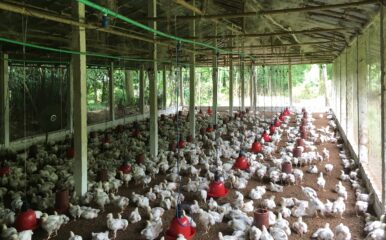
Bespoke app tracks poultry traders to reveal points of infectious disease risk
Published on 14/03/2022
The One Health Poultry Hub TRACKING App is a truly inclusive One Health tool in the Hub tradition, bringing together researchers with different expertise working across different institutions and countries. It allows research participants to record a variety of data on their mobile phones, making the process of evaluating infectious disease risk easier and quicker for researchers.
The TRACKING App was developed as one objective of the Hub is to record the movements of poultry and poultry products so we can map the poultry trade networks between production and marketing sites and evaluate the impact of these networks on infection patterns.

When we started out on our Hub journey, we knew from previous research in the BALZAC project, on which many of the One Health Poultry Hub researchers worked, that the infection pressure of avian influenza (‘bird flu’) changes throughout the poultry marketing chain in Bangladesh. At its simplest, this means that the quantity of avian influenza virus in a chicken or a chicken product, and their ability to infect other chickens and also people, changes depending on where that chicken or chicken product is in its journey from farm to plate. For example, BALZAC found there was low prevalence of avian influenza virus at poultry farms in Bangladesh but higher prevalence at endpoints in the marketing chain, such as at the live bird markets where most birds are traded in the country.
An app for the Poultry Hub was considered an ideal tool to record the movements of poultry traders. However, after a review of paid-for and free apps available, none was either affordable or fulfilled all the requirements of our proposed research.
App development
That was why I, together with a team of developers at Identic, in Queensland, Australia, took on the task to develop an app tailored for the data collection we required.
The result is our bespoke ‘One Health Poultry Hub TRACKING App’. This was developed, piloted and modified over a period of several months and was ready for use by the end of 2020. Since then, it has truly proved its worth, being a practical data collection tool that is able to capture movement as well as survey data at the same time.
The App was developed for Android devices and is based on the Open Data Kit, a mobile data collection software for resource-limited settings. The Open Data Kit provides free source codes, which means that the App can be modified to the needs required.
The underlying location technology in the App is combining data from multiple sensors, including the phone’s GPS, WiFi and Bluetooth, to compute geolocation readings quickly and accurately. Thus, no mobile phone reception is required to collect the movement data, as long as the GPS recording on the mobile phone is turned on.
Recording data
Poultry traders taking part in the research or researchers following these traders can download the App from a customised website. They register using a customised barcode which then allows them to update any features that might have been made to the App. As a result, the App is straightforward and easy to update.

Movement paths are visible on the phone via a Google Map interface within the App, and the recording of the paths is controlled with single ‘record’ and ‘pause’ button and an additional ‘save’ button after the journey is completed. For each poultry trading location along a movement path, a range of questions is provided that explore the trading details at that particular location, for example the type and volume of poultry sold or purchased.
All data (which include the movement paths and the survey answers) are stored on the phone and can be edited, sent or deleted. So, for example, a poultry trader does not need to complete the survey associated with a location in the field, but can do this when it is most convenient, perhaps after completing their journey. Data can then be uploaded whenever internet access is available.

Data are stored on a server and can be downloaded from anywhere across the world. For example, while data is collected by field teams in Bangladesh, PhD student Jinnat Ferdous, who is based at the University at Queensland, can download and view the data in real-time in Australia.
Mobility studies
Data collection in Bangladesh was delayed as a result of the COVID-19 pandemic, but the App is now an integral part of the Hub’s mobility study research in Bangladesh. A total of 87 of individual daily movements of poultry traders will be recorded in Bangladesh, and almost two-thirds of these have been already completed.
The data collection in the mobility research in Bangladesh is also a prime example of effective collaborative research across different work packages within the One Health Poultry Hub. In addition to the collection of movement and survey data of poultry traders through the App as part of the work to construct poultry trade networks between production and marketing sites, qualitative in-depth interviews are conducted with the same traders and their staff as part of the detailed ethnographic work, while biological sampling of birds and surfaces of transport vehicles is also performed during the same field visits.
The App is now available in five (five!) languages – English, Bangla, Vietnamese, Tamil and Gujarati – and we are now preparing to start data collection in India and Vietnam.


